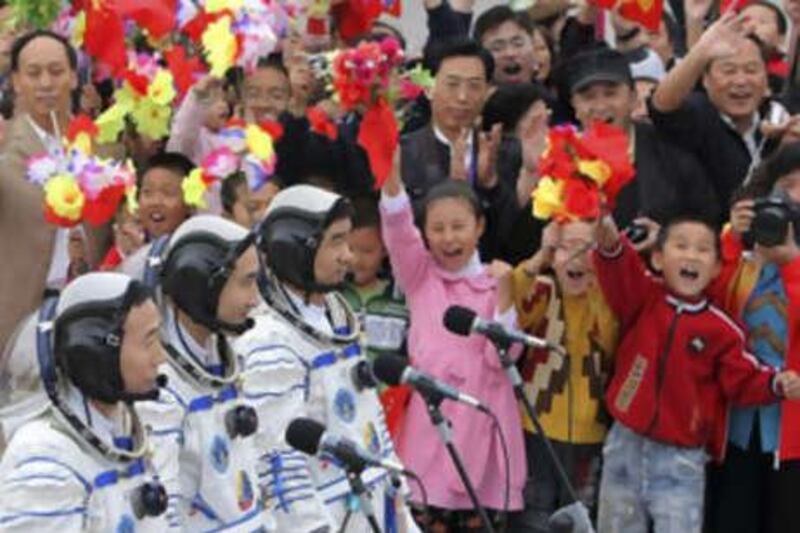BEIJING // If the worker was the icon during the height of Chinese Communism, the astronaut has become the emblem for modern-day China. Known as a "taikonaut", a Chinese-English hybrid, the country's spacemen are featured on everything from water bottles to public video screens. And at the opening ceremony of the Beijing Olympics on Aug 15, performers in spacesuits danced a weightless walk above a 16-tonne suspended globe. It was a preview of what China hopes to pull off today when Zhai Zhigang takes his first steps out into space.
The much-awaited Shenzhou VII mission is China's third manned spacecraft and launched last night from the Jiuquan Satellite Launch Center on the edge of the Badain Jaran desert in north-western Gansu province. It is manned by three experienced astronauts: Mr Zhai, Liu Boming and Jing Haipeng. "The Shenzhou VII mission is a breakthrough for China's space exploration; it is a glorious mission that has historic implications," Mr Zhai told reporters yesterday at the launch centre.
"It is a great honour for all three of us to be part of the mission, and we are fully prepared for the challenge." Unlike in the past when China's space explorations were top secret, minute details of the upcoming launch are being reported daily in the local media, including the weight of Mr Zhai's spacesuit (120kg), the cost of the launch (100 million yuan or Dh53.6m) and what they will eat: vacuum packed shredded pork and chilli sauce and grilled beef with spicy sauce. Mr Zhai will make his historic 40-minute walk nearly 600 minutes after lift-off and over 300km from Earth.
The anticipation and excitement surrounding the launch are reminiscent of similar earlier missions in the United States and the former Soviet Union over four decades ago, culminating in Neil Armstrong's historic walk on the moon in 1969. "The scale of our manned space programme is modest. It cannot be compared with that of the United States and Russia in terms of manpower and money," Ma Xingrui, deputy commander in chief of the Shenzhou VII mission, said in an interview yesterday with the China Daily at the launch site. "The status of our spaceships is that of advanced countries in the 1980s and 1990s," he said.
While it is late to join the ranks of spacewalkers, China has been reaching for the stars for thousands of years. "The Chinese emperor was known as the Son of Heaven and astronomy was critical for explaining that what happened in the heavens was related to what was happening on earth," Marc Kalinowski, a French Sinologist, said. As early as the Han Dynasty (206BC to 220AD), there was already a department of astronomy and heavenly motions were scrutinised on a daily basis in the Imperial Observatory. Outside influence and further development came with the arrival of Indian astronomers in the Tang Dynasty (618-907) and Islamic astronomers during the Yuan (1276-1644). At the end of the Ming Dynasty, the Jesuits, whose instruments can still be seen on the rooftop of Beijing's ancient observatory, caught the attention of Chinese emperors with the latest astronomical discoveries from Europe.
The tumultuous years of the 20th century, however, limited further findings. The country launched its first satellite, Dongfang-I, back in 1970 but political campaigns such as the Cultural Revolution intervened and aerospace scientists such as Yao Tongbin became political targets. Yao died in 1968 after being beaten to death by the radicalised students known as Red Guards. Mao Zedong's death in 1976 brought an end to the campaigns and allowed the country to turn from its destructive politics to industrial modernisation. Space once again became a frontier for discovery and a lucrative business of launching commercial satellites. To date, China has launched over 50 international satellites on its Long March rockets.
While it started late, China is learning quickly. The country's first manned space mission on the Shenzhou V took place in 2003, when astronaut Yang Liwei orbited the moon, making China the third country in the world to send an astronaut into space on its own aircraft. A two-man mission followed in 2005. Last year, China's first lunar investigation successfully sent back pictures of the surface of the moon. "Chinese people's dream of flying to the moon for more than 1,000 years has started to materialise," Wen Jiabao, the premier, said at a display of the photos. The country's success in outer space is being viewed as a symbol of its rising national strength, technical innovation and elevated international status. But Chinese leaders are keen to stress there are no military aims. "China's manned space programme has not carried out a single military task," Cui Jijun, director of the Launch Center, told journalists this week.
Space travel has become a hot topic in more places than just China. Neighbouring India will launch a moon probe onboard its first unmanned spacecraft, Chandrayaan-1, on Oct 22. Last week the United States also reviewed the preliminary design of the Ares 1 rocket that would launch astronauts into space in 2015. On Oct 12 a Soyuz crew, with the first US space tourist, Richard Garriott, Michael Fincke, a US astronaut, and Yuri Lonchakov, a Russian cosmonaut, will take off for the International Space Station.
Given China's aspirations, it seemed appropriate that Capt Eugene Cernan, the last man to have set foot on the moon on the Apollo XVII mission, was in China during the recent Olympic Games, together with Gen Thomas Stafford, who journeyed into space on four missions during his career as a Nasa astronaut. Like them, Mr Zhai, Mr Liu and Mr Jing are pioneers and belong to the first generation of 14 Chinese astronauts selected in 1998. All three men are 42 years old and are expected to retire soon to make way for the next generation of taikonauts who will be part of the country's future plans to build a space station before 2020.
* The National





